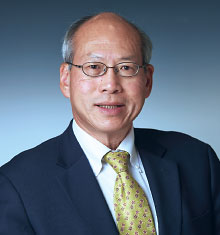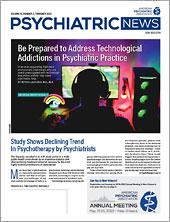The number of medical school applicants for the 2021-2022 school year set records, increasing 17.8% over 2020. The swell was driven by students from underrepresented groups: For the first time since the Association of American Medical Colleges (AAMC) began tracking the figure, most of the 2021-2022 applicants were not White.
The 2021 matriculants reflected greater diversity, as well. The rate of matriculants who were Black rose from 9.5% in 2020 to 11.3% last year, while matriculants of Hispanic, Latino, or Spanish origin rose from 12% to 12.7%.
“This is really encouraging news,” said Walter E. Wilson Jr., M.D., M.H.A., chair of APA’s Council on Minority Mental Health and Health Disparities. “This suggests we’re on the right track to making sure our medical workforce reflects the populations we serve.”
Last year, a study published in the New England Journal of Medicine (NEJM) found that from 1978 to 2019, the percentage of medical students from Black, Hispanic, and other underrepresented racial and ethnic groups remained well below their corresponding percentages in the U.S. census.
This year’s upswell in applications from students belonging to minority groups is a welcome sign, but one question looms: Will it last?
Reaching Students Earlier in Their Educations
When Devin Morris, B.A., started medical school, she made a quick observation: It was clear that the races and ethnicities of the students and teachers with whom she worked were not reflective of the patient population. Morris, a fourth-year medical student at Brown University’s Warren Alpert Medical School, initiated the NEJM study.
She said she and other students of color experienced the effects of the lack of diversity in medicine. She believed that Brown University was working to increase the population of underrepresented racial and ethnic students, but she wondered how others felt about it and to what extent some individuals were deterred from applying to medical school due to a perceived lack of diversity and support.
“A key principle of medicine is beneficence and providing the best patient care possible,” she said. “I have thought a lot about how difficult that is when the provider population is so different from the patient population.”
The study investigated four decades of data on medical school enrollment. While gender parity was achieved as early as 2005, there has been limited progress by members of racial and ethnic groups that are underrepresented in medicine. In 1978, Black men accounted for 3.1% of the national medical student body, according to the study. In 2019, that figure had dropped to 2.9%. The study also noted the importance of historically Black medical schools: “Without these schools, the percentage of enrollees who are Black men would have remained a constant 2.4% for the duration of the study period.”
(There was a modest increase in the rate of Black women in medical school, from 3.6% to 4.4%.)
Francis Lu, M.D., consultant to the Committee on Diversity, Equity, Inclusion, and Anti-Racism of the Association of Directors of Medical Student Education in Psychiatry, said the study offers a comprehensive, 40-year summary of a disturbing reality: Despite efforts on the part of medical schools, true diversity within the student body has not yet been reached. Lu is the Luke and Grace Kim Endowed Professor in Cultural Psychiatry, Emeritus at UC Davis and a member of APA’s Presidential Task Force on Social Determinants of Mental Health.
Philip Gruppuso, M.D., another author of the NEJM study and a professor of pediatrics and medical science at Brown University, explained that he and his colleagues’ work emphasized a fundamental problem: There were not nearly enough applicants from underrepresented groups to drive improvements in the diversity of the medical student population. The percentage of applicants who were men from underrepresented racial and ethnic groups remained stationary, as it did among women who identified as American Indian, Alaska Native, Native Hawaiian, or Pacific Islander (the percentages of female applicants who identified as Asian, Black, and Hispanic increased over the study period).
“This is a problem that extends all the way back to the earliest stages of people’s educations,” Gruppuso said. “It’s a reflection of racial and ethnic disparities throughout our educational system.”
There have been many efforts in medicine to improve diversity, but studies such as Morris and Gruppuso’s show there is still work to be done, said Norma Poll-Hunter, Ph.D., senior director of workforce diversity at the AAMC. For example, more medical schools have instituted “holistic reviews” when considering applicants, evaluating students on broad-based, mission-driven criteria, rather than focusing solely on MCAT scores or GPAs.
Many medical schools also have pipeline programs that attempt to prepare college students of underrepresented backgrounds for medical school. APA’s Workforce Inclusion Pipeline Program allows undergraduates to learn about the field of psychiatry while receiving mentorship from psychiatrists. The program also provides resources to prepare for medical school, as well as other learning and development opportunities. It is open to students who are underrepresented in medicine.
“But what’s become clear is that the pipelines need to go back further, all the way to elementary school,” Lu said. “Really, this is a society-wide issue, and medical schools can’t fix these trends on their own. We need structural and infrastructure changes earlier in education.”
“We can’t work in silos,” Poll-Hunter said. “There must be connections between various systems in order to make long-lasting improvements.”
A Changing Tide?
The increase in diversity among medical school applicants and matriculants for the 2021-2022 school year is very positive, but should be watched closely to determine if it continues or not, Lu said in an email. A perfect storm of factors may have been at work, including the COVID-19 pandemic.
“During the pandemic, the general public has witnessed physicians in multiple roles, whether they’re at the forefront of clinical care, research, public health, or advocacy,” Poll-Hunter said. “Health careers are part of the daily news that everyone is exposed to, and that may be why we’ve seen so many more applicants.”
Wilson pointed out that the pandemic placed existing health disparities in a stark light, highlighting the need for social justice within medicine that may have encouraged students of color to apply. “Many medical schools also allowed applicants to interview virtually, which dramatically improved access for some of our talented, underrepresented applicants who may not have the financial means to travel for interviews,” he said.
There is still a lot of work to be done. Wilson pointed to the importance of ensuring there is a representative number of men of color within medicine, and particularly within psychiatry. The rate of males who were accepted for the 2021-2022 school year decreased by 1%, while the rate of male matriculants fell by 2.1%. “When it comes to [people] of color, particularly Black males and Latino/Hispanic males, access to care is often an issue,” Wilson said. “We don’t always feel welcome in mental health care especially.”
The upswell in applicants for the 2021-2022 academic year may be an aberration. According to the AAMC, medical schools report that applications for the 2022-2023 school year have been closer to the levels seen prior to the pandemic. Wilson pointed out that steps must be taken to ensure greater diversity among applicants and matriculants continues, such as by continuing to allow virtual interviews.
“We must continue to be intentional about diversity and inclusion,” he said. ■
“Diversity of the National Medical Student Body—Four Decades of Inequities” is posted
here.
“Medical School Applicants and Enrollments Hit Record Highs; Underrepresented Minorities Lead the Surge” is posted
here.
More information on APA’s Workforce Inclusion Pipeline Program is posted
here.


